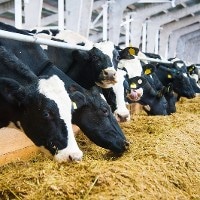Dec 18 2018
The agricultural industry is the world’s largest source of non-CO2 greenhouse gas emissions, and IIASA-led study has discovered that shifting agricultural practices and a change in diet away from meat and dairy products could lower the sector’s emissions by up to 50% by 2050 compared to a situation without mitigation attempts.
 © Grigorenko | Dreamstime.com
© Grigorenko | Dreamstime.com
IIASA researcher Stefan Frank led the team which conducted the first comprehensive analysis of agricultural non-CO2 mitigation using a combination of four different global economic models and evaluated the reduction potential. They used the carbon price in the models to approximate the mitigation potential of each option, although Frank emphasizes that carbon taxes are not considered a probable policy instrument for the agricultural industry in reality.
“We gain insights on the contribution of different mitigation options across regions and identify robust emission reduction strategies both on the supply and demand side,” he says.
Efforts made by the agricultural sector alone could lower about 15% of agricultural methane and nitrous oxide emissions by 2050, a total of 0.8-1.4 gigatons of carbon dioxide equivalent per year (Gt CO2e/year), at an already low cost of US$20/ton CO2e. Dietary variations in over-consuming countries could contribute extra reductions of 0.6 Gt CO2e/year, a total emissions reduction of 23%.
The scientists used the Global Biosphere Management Model (GLOBIOM), developed at IIASA, and CAPRI, MAGNET, and IMAGE developed by the University of Bonn, Wageningen University, and PBL Netherlands Environmental Assessment Agency, respectively, to model eight carbon price trajectories ranging from US$20/ton CO2e discharged, to US$950/ton CO2e by 2050 to estimate the economic emission reduction potential from the sector. This maximum figure is thought to be the price required to meet the 1.5 °C climate stabilization target spanning all sectors of the economy.
At the highest carbon prices of US$950/ton CO2e, agriculture could realize emissions reductions of 3.9 Gt CO2e/year by 2050, 50% lower than the baseline situation without climate change alleviation efforts.
Methane and nitrous oxide emissions from agriculture presently constitute 10-12% of anthropogenic greenhouse gas emissions, and the percentage is increasing, mainly thanks to the increased use of synthetic fertilizers and growing ruminant herds. Since 1990, emissions have grown by a third, but the data reveal that production is up by 70%, so agriculture is becoming more competent over time. If the world is to achieve the 1.5 °C climate stabilization target put forth by the Paris Agreement, however, these emissions will need to decrease.
The beef and dairy sectors are extremely greenhouse gas intensive, and across all models and carbon price situations, had the potential to contribute over two-thirds of the total mitigation potential in agriculture.
Frank and his colleagues drew up three areas for mitigation on the supply side—technical options such as animal feed supplements to enhance feed digestibility or anaerobic digesters, production effects such as variations in production levels, and structural options, which are more fundamental changes to agriculture such as changes to livestock and crop portfolios. Demand side options involved consumers in emerging and developed countries changing their diets to consume fewer animal products.
Steering mitigation action towards a limited number of regions, such as Africa, China, India, and Latin America, and commodities such as beef and milk, which are characterized by relatively high emission intensities, would allow for the realization of substantial emissions savings on the supply side.
Stefan Frank, Researcher, IIASA.
The models reveal that as carbon prices rise, technical and structural options become exhausted, after which emissions reductions can be accomplished through decreasing production and consumption of greenhouse gas intensive items, such as dairy and meat. Such dietary modifications would have an added advantage. As demand declines in over-consuming countries, less nitrous oxides and methane is released while simultaneously it would also produce a more balanced distribution of the calorie consumption from dairy and meat across more world regions with benefits for food security.
The models agree that diet change can contribute only part of the efforts needed to achieve the 1.5 °C climate stabilization target and policymakers should not forget about the production side measures which in this study provide the large majority of the mitigation potential. The comparison across multiple models also shows that there are still substantial uncertainties in the reference level non-CO2 emissions development and the related mitigation potential. Unless these uncertainties are reduced, they will need to be factored in the plans of deployment of negative emissions technologies.
Petr Havlík, Study Co-Author and Researcher, IIASA.
As nations will have to intermittently monitor progress and evaluate the implementation of the Paris Agreement, the insights provided in the research could help policymakers to locate regional mitigation priorities in the sector and have a proper understanding of the potential contribution of agriculture.